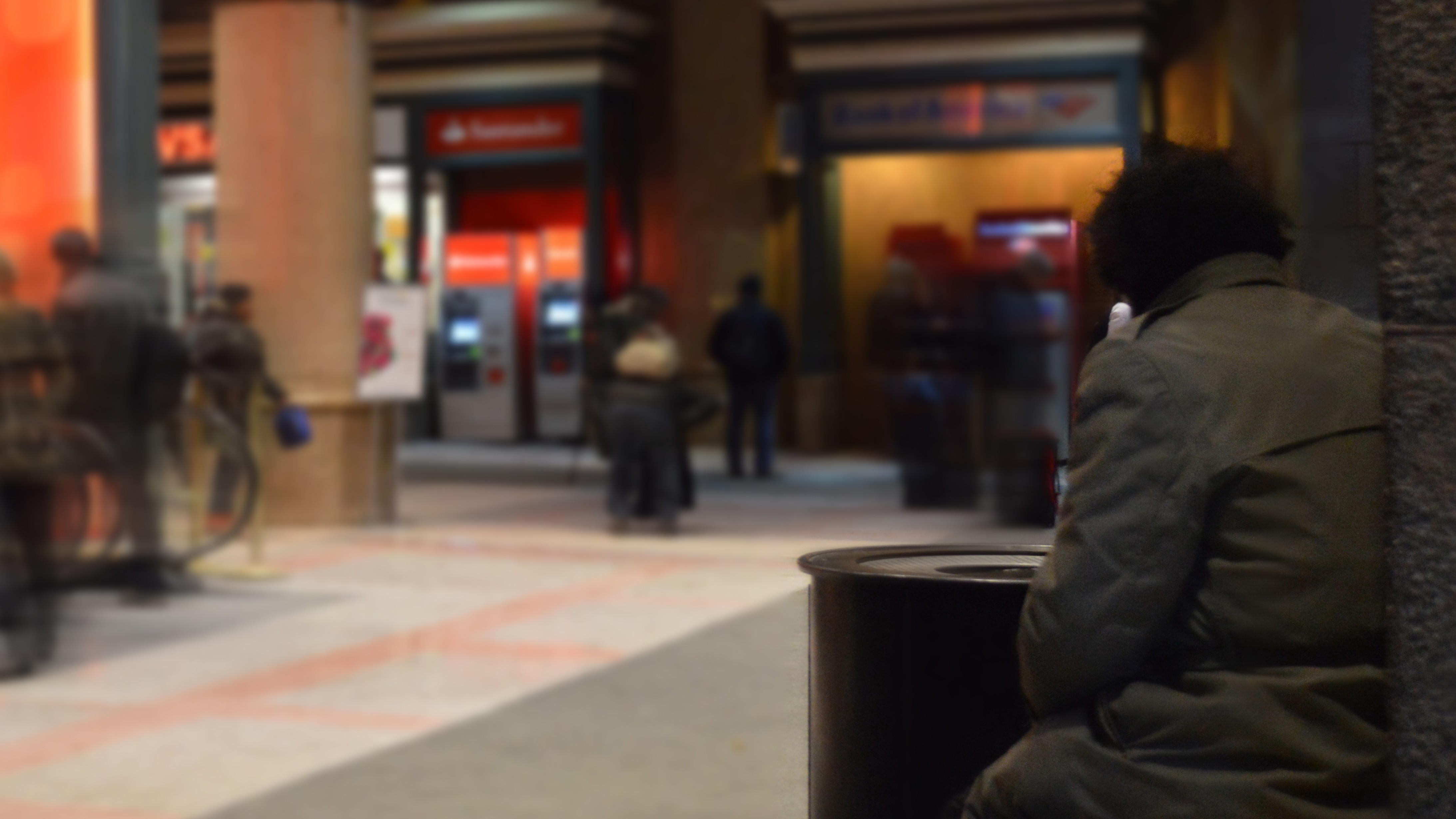A group of six takes up an isolated corner of South Station’s food court, on the second floor, talking loudly, joking and keeping warm. The group takes up two tables, four men, two women. All six are homeless and unsheltered.
One couple in the group has a tall wire caddy filled with trash bags. Despite the snowiest winter in recent Boston history—over six feet already—they’re happier camping out in the streets or in South Station than dealing with city-run facilities. Shelters have rules, restrictions, people stealing things and not everyone gets along with the workers.
“Couples can’t stay together in the shelter,” says Dan, pointing to his girlfriend.
“We’d much rather gather all of our blankets and camp out here,” adds Jack. The young man and his girlfriend prefer staying in motels whenever possible. The group had rarely stayed at South Station before this winter. Jack has stayed at Logan Airport in the past. The airport traditionally remains open in the winter and doesn’t kick out the homeless. Jack and his friend, Steve, have also built igloos during blizzards—sometimes out of snow, sometimes with cardboard and snow. I say it sounds risky, especially with snow plows roaming the streets.
“We’re always at risk,” Steve says, laughing.
With Boston’s homelessness rate one of the highest in the country, lots of folks are at risk. In addition to igloo sightings in East Boston and Cambridge’s Harvard Square, there are stories of homeless people sleeping on MBTA train tracks in the tunnels and camping out in the snow under tents.
McKenzie Ridings from the Boston Public Health Commission discourages makeshift shelters, “which in many instances don’t provide adequate protection from hypothermia,” she says, adding that low temperatures, freezing wind and wet conditions increase the risk. “Unsheltered homeless individuals may also be putting themselves at additional risk for carbon monoxide poisoning or burn injuries if using fuel burning sources for heat in enclosed, unventilated places,” she adds.
Ridings continues, “Homeless individuals in provisional shelters behind buildings or under vehicles are not easily monitored for their safety and health and may become hypothermic and seriously ill or even die before public safety, outreach crews or even bystanders can assist them in seeking medical care.” Alcohol and drug abuse exacerbate the risk, adds Ridings, because substances “reduce their level of altertness.”
The U.S. Department of Housing and Urban Development estimated that Massachusetts had the second highest increase of homelessness in the country between 2013 and 2014, after New York, and that the current population is 21,237. Boston also has more people in its emergency shelter system than any other major city in the country. The study found that the Commonwealth had one of the lowest rates of unsheltered homeless in the country, about 759 individuals, but such numbers are traditionally hard to pin down. At any rate, there are enough unsheltered people in Boston to warrant certain emergency protocols.
Chief Kenneth Green of the MBTA transit police says that as long as the hostile weather continues, South Station and North Station will remain open to the homeless. It won’t last the entire winter and individuals who wish to stay overnight aren’t allowed to come and go—if you want to stay in South Station, you have to remain there all night. He adds that transit police will also help transport individuals who want to be taken to a shelter. Before winter storm Juno hit, Mayor Martin J. Walsh’s office also announced that shelters would provide amnesty for previous offenders during the harsh weather.
Additionally, local groups like C.O.P.E. (Communities Offering Practical Encouragement) are organizing outerwear deliveries during the winter while vigilantly requesting the city keep South and North Stations open. Katherine Bennett, one of the group’s co-founders, says that C.O.P.E. often performs outreach in the early evening so they can help people who didn’t get into shelters, which often close between 4 p.m. and 7 p.m.
As unusual as this winter is, it doesn’t take an exceptionally frigid winter to be deadly. As ThinkProgress points out, “Hypothermia can set in at temperatures well above freezing, and many cities don’t open their emergency winter shelters until temperatures drop far below that.”
They add that exposure leads to thousands of deaths around the country. ThinkProgress also noted back in November that even warmer areas of the country, like Oklahoma and California, can reach deadly freezing temperatures—citing the freezing deaths of seven homeless people in California during the winter of 2013.
Furthermore, a 2010 study from The National Coalition for the Homeless found that, “Seven hundred people experiencing or at risk of homelessness are killed from hypothermia annually in the United States.”
New England and New York have taken measures to help the unsheltered recently. Earlier this winter, New York City opened up “safe havens,” transitional housing with fewer rules than a traditional shelter but still offering social services and meals.
Churches around the northeast have also started taking in more of the homeless, from overnight shelters in NYC to daytime warming centers in Boston. (BostonWarm and Friday Café, founded by local religious leaders, were highlighted previously in Spare Change News.) Worcester also has police providing outreach to the homeless in the county.
Forbes also shared a list of hypothermia hotlines around the country last winter. They listed the number 617-534-2526 for Friends of Boston’s Homeless and 311. Mayor Walsh has also encouraged people to call 911 should they see people in need.
Six feet of snow is bizarre, but the cold is very common. As the Rev. John Edgerton of Old South Church and BostonWarm previously told Spare Change News, “The cold is the enemy.”

Leave a Reply
You must be logged in to post a comment.